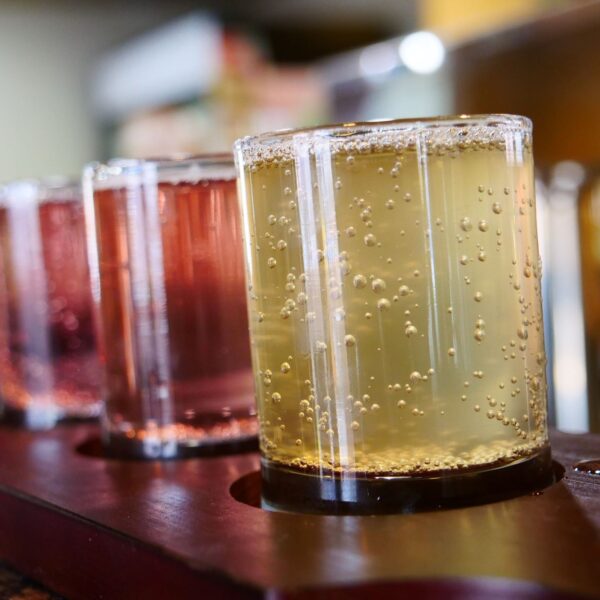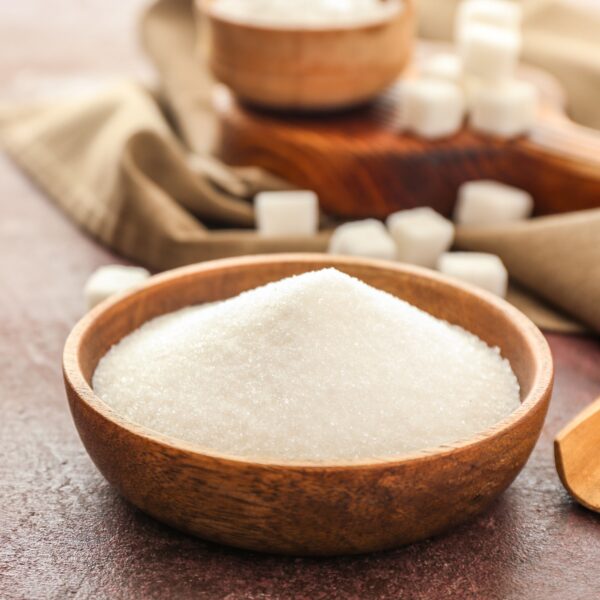Butyric acid, also known as butanoic acid, is a short-chain fatty acid commonly used as a flavoring agent in the food industry. It imparts a taste similar to lactic acid, often associated with fresh bread, butter, and yogurt.
What is Butyric Acid?
Butyric acid is a straight-chain alkyl carboxylic acid with the chemical formula CH3CH2CH2CO2H. It is also known as butanoic acid, ethylacetic acid, 1-propanecarboxylic acid, and propylformic acid. In addition to being produced by the human body, butyric acid also occurs naturally in some foods, including many dairy products — the name “butyric acid” comes from the ancient Greek word for butter.

Source: Wikipedia
How is Butyric Acid Produced?
Butyric acid occurs naturally in butter, hard cheeses such as parmesan, milk (especially from goats and sheep), yogurts, cream, and various fermented foods. Natural fats and vegetable fats typically include butyric acid in their esterified form. Butyric acid is also formed in the human colon through the bacterial fermentation of carbohydrates like dietary fiber. It supports the cellular health of the large intestine.
Industrially, butyric acid is produced through chemical synthesis involving the oxidation of butyraldehyde from propylene derived from crude oil. Butyric acid can be made via fermentation with glycolysis using several obligate anaerobic bacteria mainly belonging to the genus Clostridium. They oxidize sugar, and occasionally amylose and pectin, to pyruvate, which is then converted into butyric acid. Various agricultural residues are being explored as substrates for butyric acid’s microbial production.
Applications in the Food Industry
Butyric acid is a multipurpose food additive used as a flavoring agent, flavor enhancer, and preservative. The characteristic taste of butyric acid accounts for its extensive use in flavoring, as it provides buttery overtones to food products. Butyric acid esters are frequently used as preservatives to boost fruit aroma.
Product Examples
| Category | Examples |
| Dairy | Cheese, Cream, Butter, Ghee |
| Confectionery | Candies, Gummies, Soft Chews, Frozen Desserts |
| Bakery | Cake, Bread |
| Beverages | Dairy-Based Beverages, Fruit Beverages |
| Chocolates | Chocolates & Compounds |
| Other Products | Fruit Preparations, Dairy Alternatives, Cheese Analogues |
Properties of Butyric Acid
| Physical Form | Liquid |
| Color | Colorless |
| Odor | Unpleasant |
| Molar Mass | 88.106 g·mol−1 |
| Melting Point | −5.1 °C |
| Boiling Point | 163.7 °C |
| Density | Solid: 1.135 g/cm3 (−43 °C)Liquid: 0.9528 g/cm3 (25 °C) |
| Solubility (Aqueous) | 60 g/L |
| pKa | 4.82 |
| pH (0.1 M) | 2.92 |
| Vapor Pressure (20°C) | 0.112 kPa |
| Viscosity (15°C) | 1.814 cP |
| Refractive Index | 1.3991 |
Typical Formulations
Cheese Flavoring
| Ingredient | % Composition |
| 2-phenyl ethanol | 3.3 |
| 3-methyl-l-butanol | 11.0 |
| 2-methyl-l-butanol | 1.0 |
| Butanol | 0.3 |
| Isobutanol | 3.0 |
| Hexanol | 0.7 |
| 2- pentanol | 0.3 |
| 2-heptanol | 0.2 |
| 2-nonanol | 0.2 |
| Propionic acid | 2.0 |
| Iso-butyric acid | 9.0 |
| Butyric acid | 50.0 |
| 3-methyl butanoic acid 14.8 | 14.0 |
| Caproic acid | 8.0 |
| Piperidine | 0.3 |
| Pyrrolidine | 0.3 |
| Triethyl amine | 0.05 |
| Dimethyl amine | 1.3 |
| Trimethyl amine | 2.0 |
| Water | 13.45 |
Source: Google Patents
Beverage Syrup
| Ingredient | % Composition |
| Orange oil | 2.60% |
| Sucrose acetate isobutyrate | 4.00% |
| Starch emulsifier | 15.00% |
| Sodium benzoate, preservative | 0.10% |
| Citric acid, acidulate | 0.35% |
| Water | 78.00% |
Source: Google Patents
Butyric Acid Formulation Considerations
| Physical Form | Liquid |
| Stability | – Heat: Volatile fatty acid (Above 72°C explosive vapor/air mixtures may be formed) – Oxidation: Labile |
| Sensory Attributes | – Appearance: Oily, colorless liquid – Taste: Somewhat like butter – Odor: Foul and unpleasant, but quickly masked by other odors when used in small quantities. |
| Dosage | 0.05 to 2% (depending on the application) |
| Effects on Sensory Properties | It is a typical carboxylic acid and may react with bases. |
| Interaction with Other Components | It is a typical carboxylic acid and may react with bases |
Biological Activity of Butyric Acid
Butyrate is a critical microbial metabolite that mediates the effects of gut microbiota on the immune system. It is vital in maintaining intestinal immune homeostasis and has potential therapeutic implications for gastrointestinal and systemic disorders.
Gut microbiota fermentation of dietary polysaccharides produces short-chain fatty acids (SCFAs) that have been shown to have significant effects on host immunity and the ability to mediate colonization resistance against bacterial enteric infection. SCFAs have been tested for their impact on Salmonella biofilm and effectively prevent growth. Butyrate could effectively reduce bacterial motility. In studies, bacterial adhesion to and invasion of Caco-2 cells were also significantly inhibited.
Safety & Regulatory Considerations
| FDA Information | Butyric acid is generally recognized as safe (GRAS) by the FDA and is considered safe for consumption when used in food. It is categorized under synthetic flavoring substances and adjuvants under 21 CFR582.60. |
| EU Information | Butyric acid is an approved flavoring agent for foodstuffs listed in the FLAVIS Database of the EU under number 08.005. It can be used in all categories of flavored foods. |
| FEMA Information | The Flavor Extracts Manufacturers’ Association concludes that butyric acid is GRAS for use in food (FEMA Number 2221). |
Identification Numbers
| CAS Number | 107-92-6 |
| EC Number | 203-532-3 |
| JECFA Number | 87 |
| FEMA Number | 2221 |
Acceptable Limits or Maximum Usage
The average maximum usage levels for butyric acid in various food categories are provided in the table below.
| Category | Average Maximum Use Level |
| Baked Goods | 44/106 |
| Non-Alcoholic Beverages | 9/16 |
| Alcoholic Beverages | 3.5/30 |
| Chewing Gum | 60/270 |
| Condiments | 125/200 |
| Fats & Oils | 9/26 |
| Frozen Dairy | 9/14 |
| Gelatins & Puddings | 13/45 |
| Hard Candy | 39/103 |
| Imitation Dairy | 101/183 |
| Meat Products | 7/7 |
| Milk products | 15/15 |
| Snack Food | 24/48 |
| Soft Candy | 32/42 |
| Sweet Sauces | 9/9 |
Source: FEMA
Fun Facts About Butyric Acid
- Butyrate is produced when “good” bacteria in the gut help the body break down the dietary fiber in the large intestine (colon).
- While mammals with good scent detection abilities, such as dogs, can detect butyric acid at ten parts per billion, humans can detect it only in concentrations above ten parts per million.
Additional Resources
- Butyric Acid and Its Role in Gut Health – NCBI (PMC)
- Butyric Acid and Its Beneficial Effects on Intestinal Health – NCBI (PMC)
- Butyric Acid: Sources, Production, and Applications – MDPI
- Butyric Acid: A Short-Chain Fatty Acid with Multiple Biological Functions – NCBI (PMC)
- Title 21 – Food and Drugs, Subpart G – Code of Federal Regulations
- European Union Food Flavourings Database – Butyric Acid
- FEMA Flavor Ingredient Library – Butyric Acid










